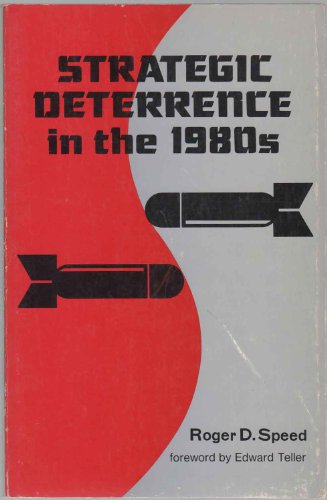Articles liés à Strategic Deterrence in the 1980's

L'édition de cet ISBN n'est malheureusement plus disponible.
Afficher les exemplaires de cette édition ISBNLes informations fournies dans la section « Synopsis » peuvent faire référence à une autre édition de ce titre.
- ÉditeurHoover Institution Press,U.S.
- Date d'édition1979
- ISBN 10 0817971424
- ISBN 13 9780817971427
- ReliureBroché
- Nombre de pages187
Acheter D'occasion
état : Assez bonClean, unmarked, crease-free spine... En savoir plus sur cette édition
Frais de port :
EUR 4,78
Vers Etats-Unis
Meilleurs résultats de recherche sur AbeBooks
Strategic Deterrence in the 1980s (Hoover Institution publication ; 214)
Description du livre Soft cover. Etat : Very Good. Clean, unmarked, crease-free spine. TM/Mil Sc. N° de réf. du vendeur ABE-1646960923824
Strategic Deterrence in the 1980s
Description du livre Trade paperback. Etat : Very good. Presumed First Edition, First printing. [16], 174, [2] pages. Wraps, Formulae. Figures. Map. Tables. Notes. Index., Foreword by Edward Teller. This is Hoover Institution Publication Number 214. The author was a physicist and senior defense analyst at R & D Associates in Marina del Rey, California. He was formerly a consultant to the Air Force, the National Academy of Sciences, and to the Director of Naval Laboratories. Dr. Speed earned his Ph.D. in Applied Physics from the University of California, Davis/Livermore. This work was supported by the National Fellowship Program of the Hoover Institution. This work provides the most extensive discussion of the vulnerability of U.S. strategic forces available at the time in the open literature. It suggests a fundamental change of NATO defense policy and describes a new plan to implement this change. The growth of Soviet military power presented a formidable challenge to the West. If deterrence were to be preserved in the 1980s, serious questions about the vulnerability of U.S. strategic forces, arms control, the defense of Western Europe, and U.S. strategic targeting doctrine need to be addressed and resolved. The author addressed these and other issues , offered possible solutions to deal with the threat to U.S. strategic forces, and suggested a new policy to cope with Soviet power in the 1980s. Deterrence theory is the idea that an inferior force, by virtue of the destructive power of the force's weapons, could deter a more powerful adversary, provided that this force could be protected against destruction by a surprise attack. This doctrine gained increased prominence as a military strategy during the Cold War with regard to the use of nuclear weapons and is related to, but distinct from, the concept of Mutual Assured Destruction, which models the preventative nature of full-scale nuclear attack that would devastate both parties in a nuclear war. Deterrence is a strategy intended to dissuade an adversary from taking an action not yet started by means of threat of reprisal, or to prevent them from doing something that another state desires. The strategy is based on the psychological concept of the same name. A credible nuclear deterrent, Bernard Brodie wrote in 1959, must be always at the ready, yet never used. Thomas Schelling's (1966) classic work on deterrence presents the concept that military strategy can no longer be defined as the science of military victory. Instead, it is argued that military strategy was now equally, if not more, the art of coercion, of intimidation and deterrence. Schelling says the capacity to harm another state is now used as a motivating factor for other states to avoid it and influence another state's behavior. To be coercive or deter another state, violence must be anticipated and avoidable by accommodation. It can therefore be summarized that the use of the power to hurt as bargaining power is the foundation of deterrence theory, and is most successful when it is held in reserve. N° de réf. du vendeur 40810

